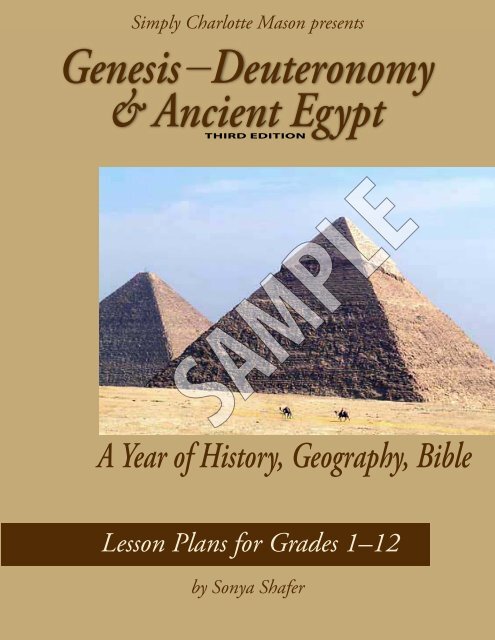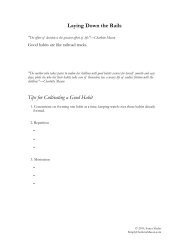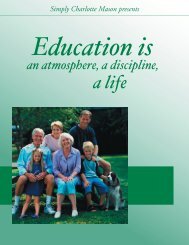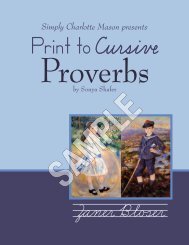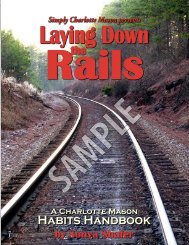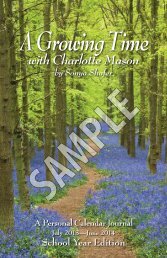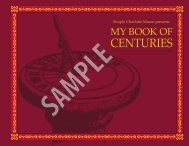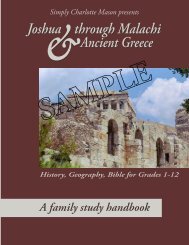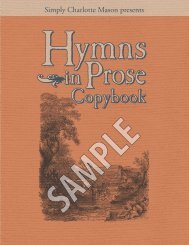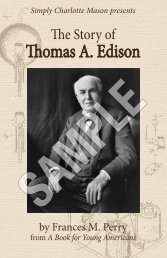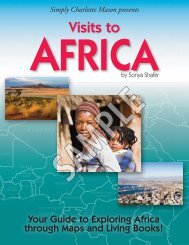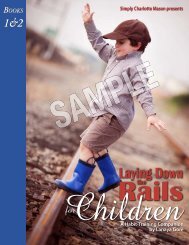Genesis through Deuteronomy & Ancient Egypt sample - Simply ...
Genesis through Deuteronomy & Ancient Egypt sample - Simply ...
Genesis through Deuteronomy & Ancient Egypt sample - Simply ...
- No tags were found...
You also want an ePaper? Increase the reach of your titles
YUMPU automatically turns print PDFs into web optimized ePapers that Google loves.
<strong>Simply</strong> Charlotte Mason presents<strong>Genesis</strong> — <strong>Deuteronomy</strong>& <strong>Ancient</strong> <strong>Egypt</strong>THIRD EDITIONA Year of History, Geography, BibleLesson Plans for Grades 1–12by Sonya Shafer
Study Bible, history, and geographytogether as a family!<strong>Genesis</strong> <strong>through</strong> <strong>Deuteronomy</strong> & <strong>Ancient</strong> <strong>Egypt</strong> will help all your students,grades 1–12, see how Bible events fit into history. This year of lesson plansfeatures the accounts of Adam to Moses, including a study of <strong>Ancient</strong><strong>Egypt</strong> and other civilizations of the time period, so students get a pictureof the world in which the Bible events happened. Older students add afascinating study of the Law given at Mt. Sinai!The Charlotte Mason-style lesson plans• Make the ancient world come alive <strong>through</strong> living books and Bible readings.• Help your students listen attentively and recall what was read by narrating.• Connect geography to the people who lived there—both past and present.• Challenge older students with interesting additional reading and writingassignments.• Keep things simple by providing helpful reminders of upcoming resources,teaching tips, and Book of Centuries entries.History, Geography, and Bible SeriesCover the entire Bible • Learn history from ancient to modern • Study all the main regions of the world<strong>Genesis</strong>—<strong>Deuteronomy</strong>& <strong>Ancient</strong> <strong>Egypt</strong>Joshua—Malachi& <strong>Ancient</strong> GreeceMatthew—Acts& <strong>Ancient</strong> RomeMiddle Ages, Renaissance,Reformation & EpistlesEarly Modern& EpistlesModern Times& Epistles, RevelationCreation—332 B.C.1856 B.C.—146 B.C.753 B.C.—A.D. 476394—15501550—18501850—2012<strong>Simply</strong>Charlotte Mason.com
<strong>Genesis</strong> <strong>through</strong> <strong>Deuteronomy</strong>& <strong>Ancient</strong> <strong>Egypt</strong>Third EditionA Year of Lesson Plansfor History, Geography, and Bible(Grades 1–12)bySonya Shafer
<strong>Genesis</strong> <strong>through</strong> <strong>Deuteronomy</strong> and <strong>Ancient</strong> <strong>Egypt</strong>, Third Edition© 2013, Sonya ShaferAll rights reserved. No part of this work may be reproduced or distributed in any form by any means—graphic, electronic, or mechanical, including photocopying, recording, taping, or storing in informationstorage and retrieval systems—without written permission from the publisher.ISBN 978-1-61634-239-5 printedISBN 978-1-61634-240-1 electronic downloadCover Design: John ShaferPublished by<strong>Simply</strong> Charlotte Mason, LLC930 New Hope Road #11-892Lawrenceville, Georgia 30045<strong>Simply</strong>CharlotteMason.com
ContentsHow to Use............................................................................................................................................... 7Complete Year’s Book List...................................................................................................................... 9Term 1..................................................................................................................................................... 13Lesson 1: (Bible) God Creates........................................................................................................................ 17Lesson 2: (Bible) Creation Details................................................................................................................ 17Lesson 3: (Bible) Adam and Eve Sin............................................................................................................ 18Lesson 4: (Bible & Geography) Cain Kills Abel & Visit 1 to Africa....................................................... 18Lesson 5: (Bible) Noah Builds the Ark......................................................................................................... 19Lesson 6: (Bible) The Waters Prevail............................................................................................................ 19Lesson 7: (Bible) The Ark Lands.................................................................................................................... 20Lesson 8: (Bible) The Languages Confused.............................................................................................. 20Lesson 9: (Geography & History) Visit 2 to Africa & Pharaoh Readings........................................... 21Lesson 10: (Bible) The Testing of Job.......................................................................................................... 21Lesson 11: (Bible) Abram Goes to <strong>Egypt</strong>................................................................................................... 22Lesson 12: (Bible) Abram Separates from Lot......................................................................................... 22Lesson 13: (Bible) Hagar Bears Ishmael..................................................................................................... 23Lesson 14: (Geography & History) Visit 3 to Africa & Pharaoh Readings......................................... 23Lesson 15: (History) The Black Land and the Red.................................................................................. 24Lesson 16: (Bible) Abram’s Household Is Circumcised......................................................................... 24Lesson 17: (Bible) Sarah Is Promised a Son.............................................................................................. 25Lesson 18: (Bible) Abraham Pleads for Sodom....................................................................................... 25Lesson 19: (Geography & History) Visit 4 to Africa & Pharaoh Readings......................................... 25Lesson 20: (History) Land Between the Rivers........................................................................................ 26Lesson 21: (Bible) God Destroys Sodom and Gomorrah..................................................................... 27Lesson 22: (Bible) Abraham Lies about Sarah Again............................................................................ 27Lesson 23: (Bible) Isaac Is Born..................................................................................................................... 27Lesson 24: (Geography & History) Visit 5 to Africa & Pharaoh Readings......................................... 28Lesson 25: (History) The Mound of the Dead.......................................................................................... 28Lesson 26: (Bible) Abraham Offers Isaac................................................................................................... 29Lesson 27: (Bible) Sarah Dies......................................................................................................................... 29Lesson 28: (Bible) A Wife for Isaac................................................................................................................ 29Lesson 29: (Geography & History) Visit 6 to Africa & Pharaoh Readings......................................... 30Lesson 30: (History) Monuments of Kings................................................................................................ 30Lesson 31: (Bible) Esau Sells His Birthright............................................................................................... 31Lesson 32: (Bible) Isaac Lies about Rebekah............................................................................................ 31Lesson 33: (Bible) Jacob Steals the Blessing............................................................................................ 32Lesson 34: (Geography & History) Visit 7 to Africa & Pharaoh Readings......................................... 32Lesson 35: (History) The Great Pyramid..................................................................................................... 33Lesson 36: (Bible) Jacob Flees....................................................................................................................... 33Lesson 37: (Bible) Jacob with Laban........................................................................................................... 33Lesson 38: (Bible) Jacob’s Sons and Flocks............................................................................................... 34Lesson 39: (Geography & History) Visit 8 to Africa & Pharaoh Readings......................................... 34Lesson 40: (History) Pharaoh’s Boat............................................................................................................ 35Lesson 41: (Bible) Jacob Flees from Laban............................................................................................... 35Lesson 42: (Bible) Jacob Meets Esau Again.............................................................................................. 35Lesson 43: (Bible) Joseph Is Sold.................................................................................................................. 36Lesson 44: (Geography & History) Visit 9 to Africa & Pharaoh Readings......................................... 36Lesson 45: (History) Silent Giants................................................................................................................ 37
Lesson 46: (Bible) Joseph Is Thrown into Prison..................................................................................... 37Lesson 47: (Bible) The Cupbearer and the Baker.................................................................................... 38Lesson 48: (Bible) Joseph Rules in <strong>Egypt</strong>.................................................................................................. 38Lesson 49: (Geography & History) Visit 10 to Africa & Pharaoh Readings...................................... 38Lesson 50: (History) The Painter’s Rulebook............................................................................................ 39Lesson 51: (Bible) Jacob Sends His Sons to <strong>Egypt</strong>................................................................................. 39Lesson 52: (Bible) Joseph’s Brothers Come Again................................................................................. 40Lesson 53: (Bible) Jacob’s Household Moves to <strong>Egypt</strong>......................................................................... 40Lesson 54: (Geography & History) Visit 11 to Africa & Pharaoh Readings...................................... 40Lesson 55: (History) Hammurabi the Lawgiver....................................................................................... 41Lesson 56: (Bible) Joseph’s Wisdom and Jacob’s Blessings................................................................. 41Lesson 57: (Bible) Jacob and Joseph Die.................................................................................................. 42Lesson 58: (Bible) <strong>Genesis</strong> Catch Up or Exam......................................................................................... 42Lesson 59: (Geography & History) Visit 12 to Africa & Independent Readings............................. 43Lesson 60: (History) Project or Exam.......................................................................................................... 43Term 2..................................................................................................................................................... 45Lesson 61: (Bible) The Israelites Enslaved................................................................................................. 49Lesson 62: (Bible) Moses Is Born.................................................................................................................. 49Lesson 63: (Bible) Moses Flees...................................................................................................................... 49Lesson 64: (Geography & History) Visit 13 to Africa & Independent Readings............................. 49Lesson 65: (History) Various Readings, Part 1.......................................................................................... 50Lesson 66: (Bible) God Calls Moses............................................................................................................. 50Lesson 67: (Bible) The Name of God........................................................................................................... 51Lesson 68: (Bible) God’s Promise and Power........................................................................................... 51Lesson 69: (Geography & History) Visit 14 to Africa & Independent Readings............................. 51Lesson 70: (History) Various Readings, Part 2.......................................................................................... 52Lesson 71: (Bible) Moses Returns to <strong>Egypt</strong>.............................................................................................. 52Lesson 72: (Bible) Brick-making Becomes Harder................................................................................. 53Lesson 73: (Bible) Two Kingdoms in Collision......................................................................................... 53Lesson 74: (Geography & History) Visit 15 to Africa & Independent Readings............................. 53Lesson 75: (History) Various Readings, Part 3.......................................................................................... 54Lesson 76: (Bible) The Plagues of Blood and Frogs............................................................................... 54Lesson 77: (Bible) The Plagues of Gnats and Flies................................................................................. 55Lesson 78: (Bible) The Plagues on Livestock and Humans................................................................. 55Lesson 79: (Geography & History) Visit 16 to Africa & Independent Readings............................. 56Lesson 80: (History) Various Readings, Part 4.......................................................................................... 56Lesson 81: (Bible) The Plague of Hail.......................................................................................................... 57Lesson 82: (Bible) The Plague of Locusts.................................................................................................. 57Lesson 83: (Bible) The Plague of Darkness............................................................................................... 57Lesson 84: (Geography & History) Visit 17 to Africa & Independent Readings............................. 58Lesson 85: (History) Various Readings, Part 5.......................................................................................... 58Lesson 86: (Bible) The Plague on the Firstborn...................................................................................... 59Lesson 87: (Bible) God Gives Instructions................................................................................................ 59Lesson 88: (Bible) Pillars of Cloud and Fire............................................................................................... 60Lesson 89: (Geography & History) Visit 18 to Africa & Independent Readings............................. 60Lesson 90: (History) Various Readings, Part 6.......................................................................................... 60Lesson 91: (Bible) A Song of Praise............................................................................................................. 61Lesson 92: (Bible) Bitter Waters Become Sweet...................................................................................... 61
Lesson 93: (Bible) God Gives Manna and Quail...................................................................................... 62Lesson 94: (Geography & History) Visit 19 to Africa & Independent Readings............................. 62Lesson 95: (History) Various Readings, Part 7.......................................................................................... 63Lesson 96: (Bible) God Provides Water and Victory............................................................................... 63Lesson 97: (Bible) Moses Gets Help............................................................................................................ 63Lesson 98: (Bible) God Meets Moses on Mt. Sinai.................................................................................. 64Lesson 99: (Geography & History) Visit 20 to Africa & Independent Readings............................. 64Lesson 100: (History) Various Readings, Part 8....................................................................................... 65Lesson 101: (Bible) God Gives the Law...................................................................................................... 65Lesson 102: (Bible) Worship the Lord Your God..................................................................................... 66Lesson 103: (Bible) Moses on the Mountain............................................................................................ 66Lesson 104: (Geography & History) Visit 21 to Africa & Independent Readings.......................... 66Lesson 105: (History) Various Readings, Part 9....................................................................................... 67Lesson 106: (Bible) The Golden Calf............................................................................................................ 67Lesson 107: (Bible) Seven Sorrows.............................................................................................................. 68Lesson 108: (Bible) God and Moses............................................................................................................ 68Lesson 109: (Geography & History) Visit 22 to Africa & Independent Readings.......................... 68Lesson 110: (History) Turtle Shells and Emperors.................................................................................. 69Lesson 111: (Bible) Pictures of Jesus........................................................................................................... 69Lesson 112: (Bible) Instructions for the Tabernacle.............................................................................. 70Lesson 113: (Bible) Setting Up the Tabernacle....................................................................................... 70Lesson 114: (Geography & History) Visit 23 to Africa & Independent Readings.......................... 71Lesson 115: (History) Leaping the Bull...................................................................................................... 71Lesson 116: (Bible) Catch Up or Exam........................................................................................................ 72Lesson 117: (Bible) Catch Up or Exam........................................................................................................ 72Lesson 118: (Bible) Catch Up or Exam........................................................................................................ 73Lesson 119: (Geography) Visit 24 to Africa............................................................................................... 73Lesson 120: (History) Project or Exam........................................................................................................ 73Term 3..................................................................................................................................................... 75Lesson 121: (Bible) God’s Army.................................................................................................................... 79Lesson 122: (Bible) The Levites..................................................................................................................... 79Lesson 123: (Bible) Nazarites......................................................................................................................... 79Lesson 124: (Geography & History) Visit 25 to Africa & Independent Readings.......................... 80Lesson 125: (History) Desert Princes.......................................................................................................... 80Lesson 126: (Bible) God’s Cloud Leads....................................................................................................... 81Lesson 127: (Bible) Murmuring.................................................................................................................... 81Lesson 128: (Bible) Wailing............................................................................................................................ 81Lesson 129: (Geography & History) Visit 26 to Africa & Independent Readings.......................... 82Lesson 130: (History) Erased from Eternity.............................................................................................. 82Lesson 131: (Bible) Miriam’s Leprosy.......................................................................................................... 83Lesson 132: (Bible) The Spies’ Reports....................................................................................................... 83Lesson 133: (Bible) Israel’s Disbelief............................................................................................................ 83Lesson 134: (Geography & History) Visit 27 to Africa & Independent Readings.......................... 84Lesson 135: (History) Opening a Door Long Locked............................................................................ 84Lesson 136: (Bible) Israel’s Choice............................................................................................................... 85Lesson 137: (Bible) Korah’s Rebellion......................................................................................................... 85Lesson 138: (Bible) A Tragic Experiment................................................................................................... 85Lesson 139: (Geography & History) Visit 28 to Africa & Independent Readings.......................... 85
Lesson 140: (History) The Transformation of Akhenaten.................................................................... 86Lesson 141: (Bible) Another Rebellion....................................................................................................... 86Lesson 142: (Bible) Aaron’s Censer.............................................................................................................. 87Lesson 143: (Bible) Aaron’s Staff................................................................................................................... 87Lesson 144: (Geography & History) Visit 29 to Africa & Independent Readings.......................... 87Lesson 145: (History) Howard Carter’s Wonderful Discovery............................................................ 88Lesson 146: (Bible) Moses Disobeys........................................................................................................... 88Lesson 147: (Bible) Grief Upon Grief........................................................................................................... 89Lesson 148: (Bible) Victory............................................................................................................................. 89Lesson 149: (Geography & History) Visit 30 to Africa & Independent Readings.......................... 90Lesson 150: (History) Ramses the Great.................................................................................................... 90Lesson 151: (Bible) Serpents.......................................................................................................................... 90Lesson 152: (Bible) War.................................................................................................................................... 91Lesson 153: (Bible) Balaam............................................................................................................................. 91Lesson 154: (Geography & History) Visit 31 to Africa & Independent Readings.......................... 92Lesson 155: (History) Men of Iron................................................................................................................ 92Lesson 156: (Bible) Balaam (continued).................................................................................................... 93Lesson 157: (Bible) Balaam (continued) ................................................................................................... 93Lesson 158: (Bible) Balaam (continued).................................................................................................... 93Lesson 159: (Geography & History) Visit 32 to Africa & Independent Readings.......................... 93Lesson 160: (History) Merchants, Policemen, and Kings..................................................................... 94Lesson 161: (Bible) Balaam (continued).................................................................................................... 94Lesson 162: (Bible) Balaam (concluded) ................................................................................................... 95Lesson 163: (Bible) Preparations.................................................................................................................. 95Lesson 164: (Geography & History) Visit 33 to Africa & Independent Readings.......................... 95Lesson 165: (History) Live and Die by the Sword................................................................................... 96Lesson 166: (Bible) Zelophehad’s Daughters.......................................................................................... 96Lesson 167: (Bible) Joshua Is Commissioned.......................................................................................... 97Lesson 168: (Bible) The Grace of God......................................................................................................... 97Lesson 169: (Geography & History) Visit 34 to Africa & Independent Readings.......................... 97Lesson 170: (History) Cyrus the Great ....................................................................................................... 98Lesson 171: (Bible) Remember God’s Goodness.................................................................................... 98Lesson 172: (Bible) Moses Reminds Israel of God’s Law...................................................................... 99Lesson 173: (Bible) Moses Dies..................................................................................................................... 99Lesson 174: (Geography & History) Visit 35 to Africa & Independent Readings.......................... 99Lesson 175: (History) A Lasting Legacy...................................................................................................100Lesson 176: (Bible) Catch Up or Exam......................................................................................................100Lesson 177: (Bible) Catch Up or Exam......................................................................................................100Lesson 178: (Bible) Catch Up or Exam......................................................................................................101Lesson 179: (Geography) Visit 36 to Africa.............................................................................................101Lesson 180: (History) Project or Exam......................................................................................................101The True God vs. The <strong>Egypt</strong>ian gods Chart............................................................................................103The Ten Plagues Chart..................................................................................................................................105Why I Wrote These Lessons.........................................................................................................................109Charlotte Mason Methods Used in This Study.....................................................................................110A Word on Mythology...................................................................................................................................112Suggestions toward Calculating Credits................................................................................................113
How to UseThis book of lesson plans contains book suggestions and assignments for every grade level, so you cancombine all of your students into one family study.• The Family instructions are for everyone to do together.• Additional Grade Level assignments are given for students to complete eitherindependently or with the parent. Your choice.• Optional hands-on activities are also listed. Feel free to skip them, substitute differentones, or add more.Complete one lesson per day to finish this study in a school year. The lesson plans in this book follow thisfive-day schedule (except the first couple of weeks that concentrate on Bible).Day 1 Day 2 Day 3 Day 4 Day 5Bible Bible Bible GeographyandHistory(Independentreading forgrades 4–12)History(Family readingand additionalreading forgrades 7–12)You will find lots of helpful information and Internetlinks on the Links and Tips page for this book athttp://simplycm.com/genesis-links.www.<strong>Simply</strong>CharlotteMason.com7
Complete Year’s Book ListFamily (all students)• <strong>Ancient</strong> <strong>Egypt</strong> and Her Neighbors by Lorene LambertA fascinating narrative of life in <strong>Ancient</strong> <strong>Egypt</strong> intertwined with captivating stories of the other civilizations thatexisted alongside her—neighbors far and near.• Bible• Exodus: A Commentary for Children and Numbers: A Commentary for Children by Nancy E. GanzThese two commentaries for children that Nancy Ganz wrote are insightful and God-honoring. They are appropriatefor any age; however, if you are teaching only a first or second grader, you may want to read a <strong>sample</strong> of one of thechapters to see if your child would enjoy them. You may want to read the commentaries for your own instructionand read aloud only portions to your child. If you decide not to use the commentaries, read just the Scripturepassages as given in the lesson plans.• The Great Pyramid by Elizabeth MannA story of the Great Pyramid and the people who built it. Similar to David Macaulay’s Pyramid, but shorter and not asmuch construction detail.• Material World and Hungry Planet: What the World Eats by Peter MenzelThese two wonderful living geography books are used with our Visits to . . . books every year in all the grades.• Pharaoh’s Boat by David WeitzmanTwo stories in one: how and why the boat was made for Pharaoh Cheops, and how it was discovered andreconstructed in the 1950s. Fascinating detail woven into the story.• The Stuff They Left Behind: From the Days of <strong>Ancient</strong> <strong>Egypt</strong> portfolioA collection of large full-color photographs of artifacts with leading thoughts and discussion questions.• Then and Now Bible Maps from Rose PublishingAn excellent geography resource used in three of our six history studies.• Visits to Africa notebook by Sonya Shafer (one for each student)Each Visits to . . . book guides your student to spend time exploring a continent or region <strong>through</strong> map work, livingbooks, and the personal photographs and living travelogue contained in Material World and Hungry Planet: What theWorld Eats. Ideas are also included for additional activities.plus . . .Grades 1–3• Boy of the Pyramids by Ruth Fosdick JonesA mystery set in <strong>Ancient</strong> <strong>Egypt</strong> and solved by a ten-year-old boy and his father. Our favorite <strong>Ancient</strong> <strong>Egypt</strong> book forthe younger grades!• The True Story of Noah’s Ark by Tom DooleyBeautiful detailed illustrations and a flowing narrative make the account of Noah come to life.Grades 4–6• The Golden Goblet by Eloise Jarvis McGrawAnother classic mystery set in <strong>Ancient</strong> <strong>Egypt</strong> and written for children but with more twists and conflict than Boy ofthe Pyramids.• The Pharaohs of <strong>Ancient</strong> <strong>Egypt</strong> by Elizabeth PayneOne of the few Landmark series books that continues to be in print. A conversational narrative of the main pharaohswho ruled <strong>Egypt</strong>.• The True Story of Noah’s Ark by Tom DooleyBeautiful detailed illustrations and a flowing narrative make the account of Noah come to life.Grades 7–9• Adam and His Kin by Ruth BeechickSpeculative yet intriguing narrative of what life may have been like for the main Bible characters <strong>through</strong> Abram.www.<strong>Simply</strong>CharlotteMason.com9
• Book of Centuries (one for each student)• The Cat of Bubastes: A Tale of <strong>Ancient</strong> <strong>Egypt</strong> by G. A. HentyHistorical fiction by a master story-teller, written in 1888.• Discovering Doctrine by Sonya Shafer (one for each student)A multi-year project for observing, recording, and organizing Biblical truths as the student reads <strong>through</strong> the Bible.• The Golden Goblet by Eloise Jarvis McGrawAnother classic mystery set in <strong>Ancient</strong> <strong>Egypt</strong> and written for children but with more twists and conflict than Boy ofthe Pyramids.• Jashub’s Journal by Rebekah Shafer, Ruth Shafer, Sonya Shafer (one for each student)A living story combined with a Bible study designed to highlight God’s wisdom in the laws He made.• Leviticus: A Commentary for Children by Nancy E. GanzDon’t let the name fool you into thinking that this book will be too babyish for your older child. Adults can learn alot from this commentary. It explains the priests’ responsibilities, the holy days that God instituted, the moral law,the civil law, funding for the Lord’s work, and more. An excellent, God-honoring overview of Leviticus, a book toooften overlooked.• Motel of the Mysteries by David MacaulayA humorous look at the guess-work that plays a part in archaeology. Leads to great discussions about what is knownand what is speculation in ancient history.• The Pharaohs of <strong>Ancient</strong> <strong>Egypt</strong> by Elizabeth PayneOne of the few Landmark series books that continues to be in print. A conversational narrative of the main pharaohswho ruled <strong>Egypt</strong>.Grades 10–12• Adam and His Kin by Ruth BeechickSpeculative yet intriguing narrative of what life may have been like for the main Bible characters <strong>through</strong> Abram.• Book of Centuries (one for each student)• Discovering Doctrine by Sonya Shafer (one for each student)A multi-year project for observing, recording, and organizing Biblical truths as the student reads <strong>through</strong> the Bible.• Jashub’s Journal by Rebekah Shafer, Ruth Shafer, Sonya Shafer (one for each student)A living story combined with a Bible study designed to highlight God’s wisdom in the laws He made.• Leviticus: A Commentary for Children by Nancy E. GanzDon’t let the name fool you into thinking that this book will be too babyish for your older child. Adults can learn alot from this commentary. It explains the priests’ responsibilities, the holy days that God instituted, the moral law,the civil law, funding for the Lord’s work, and more. An excellent, God-honoring overview of Leviticus, a book toooften overlooked.• Motel of the Mysteries by David MacaulayA humorous look at the guess-work that plays a part in archaeology. Leads to great discussions about what is knownand what is speculation in ancient history.• Uarda by Georg EbersA historical fiction written in the late 1800s that makes the political and personal aspects of <strong>Ancient</strong> <strong>Egypt</strong> comealive. Extensive footnotes document ideas and descriptions in the storyline.• Unwrapping the Pharaohs by John Ashton and David DownAn interesting and compelling new <strong>Egypt</strong>ian chronology that confirms the Biblical account.Optional Book List• The Child’s Story Bible by Catherine Vos (grades 1–3)Recommended for portions of the Old Testament account that might best be reworded to be appropriate foryounger children. (See Living Books explanation on page 110.)• Letters from <strong>Egypt</strong> by Mary Whately, edited by Sonya Shafer (grades 3–12)These letters, written by a British woman who established a school for girls in <strong>Egypt</strong> in the late 1800s, describe the10 www.<strong>Simply</strong>CharlotteMason.com
culture, climate, and customs of that country. Wonderful tie-ins to Scripture! Please note that the recommendedversion is edited. Used in the Visits to Africa plans.Other Materials• Four sheets of poster board and felt-tip markers (optional)• Model or diagram of the Tabernacle (optional)• Various materials for hands-on projects of your choice (optional)www.<strong>Simply</strong>CharlotteMason.com11
Suggestions forWhere to Find the Books<strong>Simply</strong> Charlotte Mason• <strong>Ancient</strong> <strong>Egypt</strong> and Her Neighbors by Lorene Lambert (Family)• Book of Centuries (one for each student in grades 7–12)• Boy of the Pyramids by Ruth Fosdick Jones (grades 1–3)• Discovering Doctrine by Sonya Shafer (one for each student in grades 7–12)• Jashub’s Journal by Rebekah Shafer, Ruth Shafer, Sonya Shafer (one for each student in grades 7–12)• Letters from <strong>Egypt</strong> by Mary Whately, edited by Sonya Shafer (optional for grades 3–12)• The Stuff They Left Behind: From the Days of <strong>Ancient</strong> <strong>Egypt</strong> portfolio (Family)• Visits to Africa notebook by Sonya Shafer (one for each student in the Family)Public Domain(You can probably download these for free at http://gutenberg.org, http://books.google.com, or http://archive.org.)• The Cat of Bubastes: A Tale of <strong>Ancient</strong> <strong>Egypt</strong> by G. A. Henty (grades 7–9)• Uarda by Georg Ebers (grades 10–12)Your Local Library(These are the titles that a library is most likely to have. You might also check for the titles listed under Your FavoriteBook Store. If your library does not have access to a book listed here, add it to your Book Store list.)• The Golden Goblet by Eloise Jarvis McGraw (grades 4–9)• The Great Pyramid by Elizabeth Mann (Family)• Motel of the Mysteries by David Macaulay (grades 7–12)• Pharaoh’s Boat by David Weitzman (Family)Your Favorite Book Store(Check http://amazon.com, http://christianbook.com, http://rainbowresource.com, or other favorite book sources.)• Adam and His Kin by Ruth Beechick (grades 7–12)• Bible (Family)• The Child’s Story Bible by Catherine Vos (optional for grades 1–3)• Exodus: A Commentary for Children by Nancy E. Ganz (Family)• Hungry Planet: What the World Eats by Peter Menzel (Family)• Leviticus: A Commentary for Children by Nancy E. Ganz (grades 7–12)• Material World by Peter Menzel (Family)• Numbers: A Commentary for Children by Nancy E. Gan (Family)• The Pharaohs of <strong>Ancient</strong> <strong>Egypt</strong> by Elizabeth Payne (grades 4–6)• Then and Now Bible Maps from Rose Publishing (Family)• The True Story of Noah’s Ark by Tom Dooley (grades 1–6)• Unwrapping the Pharaohs by John Ashton and David Down (grades 10–12)Visit http://simplycm.com/genesis-linksfor helpful links to the books.12 www.<strong>Simply</strong>CharlotteMason.com
Term 1(12 weeks; 5 lessons/week)Term 1 Book ListFamily• <strong>Ancient</strong> <strong>Egypt</strong> and Her Neighbors by Lorene Lambert• Bible• The Great Pyramid by Elizabeth Mann• Material World and Hungry Planet: What the World Eats by Peter Menzel• Pharaoh’s Boat by David Weitzman• The Stuff They Left Behind: From the Days of <strong>Ancient</strong> <strong>Egypt</strong> portfolio• Then and Now Bible Maps from Rose Publishing• Visits to Africa notebook by Sonya Shafer (one for each student)Plus . . .Grades 1–3• The True Story of Noah’s Ark by Tom DooleyGrades 4–6• The Pharaohs of <strong>Ancient</strong> <strong>Egypt</strong> by Elizabeth Payne• The True Story of Noah’s Ark by Tom DooleyGrades 7–9• Adam and His Kin by Ruth Beechick• Book of Centuries (one for each student)• Discovering Doctrine by Sonya Shafer (one for each student)• The Golden Goblet by Eloise Jarvis McGraw• The Pharaohs of <strong>Ancient</strong> <strong>Egypt</strong> by Elizabeth PayneGrades 10–12• Adam and His Kin by Ruth Beechick• Book of Centuries (one for each student)• Discovering Doctrine by Sonya Shafer (one for each student)• Uarda by Georg Ebers• Unwrapping the Pharaohs by John Ashton and David DownOptional• The Child’s Story Bible by Catherine Vos (grades 1–3)Other Materials• Four sheets of poster board and felt-tip markers (optional)• Various materials for hands-on projects (optional)1TERMWhat You Will CoverAs a FamilyBible: <strong>Genesis</strong>Geography: Africa ,with specialemphasis on <strong>Egypt</strong> and MaliHistory: <strong>Ancient</strong> <strong>Egypt</strong>iangeography, pyramids, and art;ancient civilizations in Sumer, theIndus Valley, Great Britain, andBabylonwww.<strong>Simply</strong>CharlotteMason.com 13
1TERMTerm 1 At a GlanceFamily Grades 1-3 Grades 4-6 Grades 7-9 Grades 10-12Week 1, Lessons 1–5Bible <strong>Genesis</strong> 1–6 Adam and His Kin,ch. 1–8Geography Visits to Africa, Visit 1Adam and His Kin,ch. 1–8Week 2, Lessons 6–10Bible <strong>Genesis</strong> 7–11; Job True Story ofNoah’s ArkTrue Story ofNoah’s ArkAdam and His Kin,ch. 9–16Adam and His Kin,ch. 9–16HistoryPharaohs of<strong>Ancient</strong> <strong>Egypt</strong>, ch.1A; Golden Goblet,ch. 1Unwrapping thePharaohs, ch. 1;Uarda, ch. 1Geography Visits to Africa, Visit 2Week 3, Lessons 11–15Bible <strong>Genesis</strong> 12, 13, 16 Adam and His Kin,ch. 17–19History<strong>Ancient</strong> <strong>Egypt</strong> &Her Neighbors,ch. 1Geography Visits to Africa, Visit 3Pharaohs of<strong>Ancient</strong> <strong>Egypt</strong>,ch. 1APharaohs of<strong>Ancient</strong> <strong>Egypt</strong>, ch.1B; Golden Goblet,ch. 2Adam and His Kin,ch. 17–19Unwrapping thePharaohs, ch. 2;Uarda, ch. 2Week 4, Lessons 16–20Bible <strong>Genesis</strong> 17, 18History<strong>Ancient</strong> <strong>Egypt</strong> &Her Neighbors,ch. 2Pharaohs of<strong>Ancient</strong> <strong>Egypt</strong>,ch. 1BPharaohs of<strong>Ancient</strong> <strong>Egypt</strong>, ch.2A; Golden Goblet,ch. 3Unwrapping thePharaohs, ch. 3;Uarda, ch. 3Geography Visits to Africa, Visit 4Week 5, Lessons 21–25Bible <strong>Genesis</strong> 19–21History<strong>Ancient</strong> <strong>Egypt</strong> &Her Neighbors,ch. 3Pharaohs of<strong>Ancient</strong> <strong>Egypt</strong>,ch. 1CPharaohs of<strong>Ancient</strong> <strong>Egypt</strong>, ch.2B; Golden Goblet,ch. 4Unwrapping thePharaohs, ch. 4;Uarda, ch. 4Geography Visits to Africa, Visit 5Week 6, Lessons 26–30Bible <strong>Genesis</strong> 22–24History<strong>Ancient</strong> <strong>Egypt</strong> &Her Neighbors,ch. 4Pharaohs of<strong>Ancient</strong> <strong>Egypt</strong>,ch. 2APharaohs of<strong>Ancient</strong> <strong>Egypt</strong>, ch.3A; Golden Goblet,ch. 5Unwrapping thePharaohs, ch. 5;Uarda, ch. 5Geography Visits to Africa, Visit 614 www.<strong>Simply</strong>CharlotteMason.com
Use this chart to see what your family and each of your students will be studying week by weekduring this term. You will also be able to see when each book is scheduled to be used.1TERMBible <strong>Genesis</strong> 25–27Family Grades 1-3 Grades 4-6 Grades 7-9 Grades 10-12Week 7, Lessons 31–35History The Great Pyramid Pharaohs of<strong>Ancient</strong> <strong>Egypt</strong>,ch. 2BGeography Visits to Africa, Visit 7Bible <strong>Genesis</strong> 28–30Week 8, Lessons 36–40History Pharaoh’s Boat Pharaohs of<strong>Ancient</strong> <strong>Egypt</strong>,ch. 2CGeography Visits to Africa, Visit 8Bible <strong>Genesis</strong> 31–37Week 9, Lessons 41–45Pharaohs of<strong>Ancient</strong> <strong>Egypt</strong>, ch.3B; Golden Goblet,ch. 6Golden Goblet,ch. 7, 8Unwrapping thePharaohs, ch. 6;Uarda, ch. 6Unwrapping thePharaohs, ch. 7;Uarda, ch. 7History<strong>Ancient</strong> <strong>Egypt</strong> &Her Neighbors,ch. 5Pharaohs of<strong>Ancient</strong> <strong>Egypt</strong>,ch. 3AGolden Goblet, ch.9, 10Unwrapping thePharaohs, ch. 8;Uarda, ch. 8Geography Visits to Africa, Visit 9Week 10, Lessons 46–50Bible <strong>Genesis</strong> 39–41History<strong>Ancient</strong> <strong>Egypt</strong> &Her Neighbors,ch. 6Pharaohs of<strong>Ancient</strong> <strong>Egypt</strong>,ch. 3BGolden Goblet, ch.11, 12Unwrapping thePharaohs, ch. 9;Uarda, ch. 9Geography Visits to Africa, Visit 10Week 11, Lessons 51–55Bible <strong>Genesis</strong> 41–47History<strong>Ancient</strong> <strong>Egypt</strong> &Her Neighbors,ch. 7Pharaohs of<strong>Ancient</strong> <strong>Egypt</strong>,ch. 3CGolden Goblet, ch.13, 14Unwrapping thePharaohs, ch. 10;Uarda, ch. 10Geography Visits to Africa, Visit 11Week 12, Lessons 56–60Bible<strong>Genesis</strong> 47–50; Exam or Catch upHistory Exam or Project Golden Goblet, ch.15, 16Uarda, ch. 11–13Geography Visits to Africa, Visit 12www.<strong>Simply</strong>CharlotteMason.com 15
Lesson 1: God Creates1TERMMaterials Needed• Bible• Adam and His Kin (grades 7–12)• Discovering Doctrine (grades 7–12)Family: Explain that you are going to start at the very beginning of history—Creation. Today you are going to find out how the world began. Read together<strong>Genesis</strong> 1:1—2:3 and ask for an oral narration.Grades 7–12: Read with your older children or assign as independent readingAdam and His Kin, chapter 1, “The Beginning of Time.”Tip: We recommend reading this book together to allow for discussion.The story makes the first twelve chapters of <strong>Genesis</strong> come alive, but thestudents must be able to recognize and discern Biblical fact from theauthor’s speculation and imagination.Grades 7–12: Encourage older children to be watching for truths aboutGod, man, or other topics that they can record in their Discovering Doctrinenotebooks. Remind them that this will be an ongoing project as they read<strong>through</strong> the Bible in the coming months (and years).Lesson 2: Creation DetailsMaterials Needed• Bible• Adam and His Kin (grades 7–12)• Discovering Doctrine (grades 7–12)Family: Ask students what they recall from last time’s reading about Creation.Explain that <strong>Genesis</strong> 1 gave the overview of Creation; today you will readmore of the details about Creation. Read together <strong>Genesis</strong> 2:4–25 and ask foran oral narration.Tip: Wherever you see an oral or written narration required <strong>through</strong>outthis study, feel free to substitute a different narration activity. You’ll findlots of great narration ideas at http://simplycm.com/narration-ideasGrades 7–12: Read with your older children or assign as independent readingAdam and His Kin, chapter 2, “In the Garden.” Continue watching for truths torecord in Discovering Doctrine.www.<strong>Simply</strong>CharlotteMason.com 17
1TERMBook of CenturiesTimelineLesson 3: Adam and Eve SinMaterials Needed• Bible• Adam and His Kin (grades 7–12)• Discovering Doctrine (grades 7–12)Family: Explain that <strong>Genesis</strong> can be summarized in eight key words: fourevents and four people. Say the eight words aloud once: Creation, Fall, Flood,Babel, Abraham, Isaac, Jacob, Joseph. Inform the students that you will bereading about the second event today: the Fall.Read together <strong>Genesis</strong> 3 and ask for an oral narration. Discuss why thisevent has been called the “Fall.” (Ideas to get you started: It depicts mankind’sfall into sin or mankind’s fall away from being “very good,” as God pronouncedat Creation.)Tip: Don’t worry about working at memorizing the eight key words.You’ll say the four key events and four key people often <strong>through</strong>out thestudy, and the children will learn them without having to work at it. Ifyou want to, you could write the eight key words on a sheet of paper orposter board and post it for the children to see. You could also use a smallarrow, moved from word to word, or simply check off the words to trackyour progress <strong>through</strong> the book of <strong>Genesis</strong>.Grades 7–12: Read with your older children or assign as independent readingAdam and His Kin, chapters 3 and 4, “The Punishment” and “Adam’s Children.”Continue watching for truths to record in Discovering Doctrine.Lesson 4: Cain Kills Abel& Visit 1 to AfricaMaterials Needed• Visits to Africa• Bible• Adam and His Kin (grades 7–12)• Discovering Doctrine (grades 7–12)Family: Complete Visit 1 in Visits to Africa.Cain and Abel (c. 4000 B.C.)Family: Ask students what they recall from last time’s reading about the Fall.Explain that today they will hear about a sad event that triggered a wholeseries of sad events, and all of them were a result of the Fall. Read together<strong>Genesis</strong> 4 and ask for an oral narration.Grades 7–12: Read with your older children or assign as independent reading18 www.<strong>Simply</strong>CharlotteMason.com
Adam and His Kin, chapters 5 and 6, “Cain” and “Writing in the Stars.” Continuewatching for truths to record in Discovering Doctrine.1TERMBook of CenturiesTimelineLesson 5: Noah Builds the ArkMaterials Needed• Bible• Adam and His Kin (grades 7–12)• Discovering Doctrine (grades 7–12)Family: Remind students of the four key events and four key people in<strong>Genesis</strong>. Say the eight words aloud once and invite the students to join in onthe ones they remember: Creation, Fall, Flood, Babel, Abraham, Isaac, Jacob,Joseph. Explain that today you will begin reading about the third event: theFlood. Read together <strong>Genesis</strong> 6 and ask for an oral narration.Grades 7–12: Read with your older children or assign as independent readingAdam and His Kin, chapters 7 and 8, “The Preachers” and “Noah.” Continuewatching for truths to record in Discovering Doctrine.Tip: From this point on, the plans will not specifically mentionDiscovering Doctrine in every lesson but will periodically remind you tomake sure older children are up to date with their Discovering Doctrinenotebooks and their Book of Centuries entries.Lesson 6: The Waters PrevailMaterials Needed• Bible• The True Story of Noah’s Ark (grades 1–6)• Adam and His Kin (grades 7–12)Family: Ask students what they remember from last time’s reading about theevents leading up to the Flood. Explain that today they will hear about Noah’stime in the ark. Read together <strong>Genesis</strong> 7 and ask for an oral narration.Grades 1–6: Read together The True Story of Noah’s Ark.Grades 7–12: Read with your older children or assign as independent readingAdam and His Kin, chapters 9 and 10, “The Year of 1656” and “The Great Flood.”The Flood (c. 2349 B.C.)www.<strong>Simply</strong>CharlotteMason.com 19
1TERMBook of CenturiesTimelineLesson 7: The Ark LandsMaterials Needed• Bible• Then and Now Bible Maps• Adam and His Kin (grades 7–12)Family: Ask students what they recall about Noah’s time in the ark. Explainthat God did not forget about Noah. Read together <strong>Genesis</strong> 8:1—9:17 andask for an oral narration.Locate Mount Ararat on map 1, Middle East - Bible Times, in Then and NowBible Maps. Use the Now overlay 2 to see in which modern day country thatmountain is located.Tip: If desired, work <strong>through</strong> <strong>Genesis</strong> 8 together to calculate how manydays Noah was in the ark. Most people think he stayed only forty days,but the total time was much longer. The rains lasted for forty days, butit took quite a while for the water to recede before Noah could leave theark.Grades 7–12: Read with your older children or assign as independent readingAdam and His Kin, chapters 11 and 12, “The Calendar Puzzle” and “Starting Upthe New World.”Lesson 8: The Languages ConfusedTower of Babel (c. 2242 B.C.)Materials Needed• Bible• Adam and His Kin (grades 7–12)Family: Remind students of the four events and four people in <strong>Genesis</strong>. Saythe eight words aloud once and invite the students to join in on the onesthey remember: Creation, Fall, Flood, Babel, Abraham, Isaac, Jacob, Joseph.Explain that today you will read about the fourth event: Babel, where theworld’s languages began. Read together <strong>Genesis</strong> 11:1–9 and ask for an oralnarration.Grades 7–12: Read with your older children or assign as independentreading Adam and His Kin, chapters 13 and 14, “Trouble at Ararat” and “Landof the Two Rivers.”Reminder: Get the book The Child’s Story Bible for lesson 13 for grades1–3 if you want to use it. (See Bible Readings note on page 110.)20 www.<strong>Simply</strong>CharlotteMason.com
Lesson 9: Visit 2 to Africa& Pharaoh Readings1TERMBook of CenturiesTimelineMaterials Needed• Visits to Africa• The Pharaohs of <strong>Ancient</strong> <strong>Egypt</strong> (grades 7–9)• The Golden Goblet (grades 7–9)• Unwrapping the Pharaohs (grades 10–12)• Uarda (grades 10–12)Family: Complete Visit 2 in Visits to Africa.Grades 7–9: Read together or assign as independent reading The Pharaohsof <strong>Ancient</strong> <strong>Egypt</strong>, chapter 1, “The Rediscovery of <strong>Ancient</strong> <strong>Egypt</strong>,” pages 3–10,stopping at the break in the text. Ask for an oral or written narration.Also assign The Golden Goblet, chapter 1.Grades 10–12: Read together or assign as independent reading Unwrappingthe Pharaohs, chapter 1, “Pyramids and Mummies.” Ask for an oral or writtennarration.Also assign Uarda, chapter 1.Tip: Beginning next week you will start the regular schedule of three daysof Bible, one day of Geography and History, and one day of full Historyeach week.Lesson 10: The Testing of JobMaterials Needed• Bible• Adam and His Kin (grades 7–12)• Discovering Doctrine (grades 7–12)Family: Ask students what they recall from last time’s reading about Babel.Explain that many people lived during the years after Babel. Read togetherJob 1:1—2:13 and 42:10–17 and ask for an oral narration.Tip: Several Bible scholars believe that Job lived during the time of thePatriarchs: Abraham, Isaac, and Jacob. So we have included his storyhere.Grades 7–12: Have older children read Job 38—42 and find characteristics ofGod to add to their Discovering Doctrine notebooks.www.<strong>Simply</strong>CharlotteMason.com 21
1TERMBook of CenturiesTimelineGrades 7–12: Read with your older children or assign as independent readingAdam and His Kin, chapters 15 and 16, “The Tower of Bel” and “Aftermath.”Abram leaves for Canaan(c. 1921 B.C.)Lesson 11: Abram Goes to <strong>Egypt</strong>Materials Needed• Bible• Then and Now Bible Maps• Adam and His Kin (grades 7–12)Family: Remind students of the four events and four people in <strong>Genesis</strong>. Saythe eight words aloud once and invite the students to join in on the onesthey remember: Creation, Fall, Flood, Babel, Abraham, Isaac, Jacob, Joseph.Explain that today’s reading begins the four key people with the account ofAbraham; however, at the time of today’s reading, his name was pronouncedAbram. Read together <strong>Genesis</strong> 12, showing Abram’s journey from Haran toCanaan to <strong>Egypt</strong> on map 1, Middle East - Bible Times, in Then and Now BibleMaps, and ask for an oral narration.Tip: In lesson 12 you will begin an emphasis on character studies of thefour main characters for your narrations covering the rest of <strong>Genesis</strong>.Label four sheets of poster board or four sheets of paper with the four maincharacters’ names, one name to a sheet: Abraham, Isaac, Jacob, Joseph.Each day after you read about one or more of the main characters, havethe children narrate what happened and what character qualities—both good or bad—they noticed. Record those character traits under theappropriate character’s name. You might want to color code the writing(for example, red for good traits and blue for bad) to visually differentiatethe good from the bad traits. If desired, require the grades 7–12 studentsto write four narrations that summarize your findings: one narrationfor each character. You can assign each written narration after readingabout the death of that character. Watch for reminders in the lessons.Grades 7–12: Read with your older children or assign as independent readingAdam and His Kin, chapters 17 and 18, “Gods and Goddesses” and “The Deathof Noah.”Lesson 12: Abram Separates from LotMaterials Needed• Bible• Character-trait posters or papers; felt-tip markers• Adam and His Kin (grades 7–12)22 www.<strong>Simply</strong>CharlotteMason.com
Family: Ask students what they recall from last time’s reading about Abramin <strong>Egypt</strong>. Explain that today’s reading will reveal a good character trait aboutAbram. Read together <strong>Genesis</strong> 13 and ask for an oral narration and charactertraits of Abram. Record students’ suggested character traits on the sheet ofposter board or sheet of paper labeled “Abraham.”1TERMBook of CenturiesTimelineGrades 7–12: Read with your older children or assign as independent readingAdam and His Kin, chapter 19, “Abram.”Lesson 13: Hagar Bears IshmaelHagar and Ishmael (c. 1910 B.C.)Materials Needed• Bible• (optional) The Child’s Story Bible• Character-trait posters or papers; felt-tip markersFamily: Ask students what they recall about God’s promises to Abram. Readtogether <strong>Genesis</strong> 12:3 and 13:14–16. Discuss how important it was for Abramto have a son to carry on the family name and start the process of becominga great nation. Read together <strong>Genesis</strong> 16 and ask for an oral narration andcharacter traits of Abram. (For younger children, you may want to read theaccount from the first portion of The Child’s Story Bible, chapter 13, rather thandirectly from <strong>Genesis</strong> 16.) Record suggested character traits on the sheet ofposter board or sheet of paper labeled “Abraham.”Lesson 14: Visit 3 to Africa& Pharaoh ReadingsMaterials Needed• Visits to Africa• The Pharaohs of <strong>Ancient</strong> <strong>Egypt</strong> (grades 4–9)• Unwrapping the Pharaohs (grades 10–12)Family: Complete Visit 3 in Visits to Africa.Grades 4–6: Read together or assign as independent reading The Pharaohsof <strong>Ancient</strong> <strong>Egypt</strong>, chapter 1, “The Rediscovery of <strong>Ancient</strong> <strong>Egypt</strong>,” pages 3–6,stopping about two-thirds of the way down the page at the break in the text.Ask for an oral or written narration.Grades 7–9: Read together or assign as independent reading The Pharaohsof <strong>Ancient</strong> <strong>Egypt</strong>, chapter 1, “The Rediscovery of <strong>Ancient</strong> <strong>Egypt</strong>,” pages 10–19.Ask for an oral or written narration.www.<strong>Simply</strong>CharlotteMason.com 23
HelpfulInformationwww.<strong>Simply</strong>CharlotteMason.com107
Why I Wrote These LessonsWhen I was growing up in Sunday School and church, I heard the stories of the Bible many times. I couldtell you all the details of Who, What, Why, and How. But I never thought about the When. I knew those Bibleaccounts were true, just like the history accounts I read were true, but I never put the two subjects together tocomprehend how Bible events fit into world history events.I also never thought about how the different Bible stories fit together. For example, I knew the story of Joseph’sbeing sold into slavery and eventually rising into the place of leadership in <strong>Egypt</strong>, and I knew the story of Mosesand the Exodus, but I never connected the two mentally as a sort of cause and effect until I studied them withmy children in chronological order. Suddenly all the pieces started fitting together!After that experience, I knew how I wanted to teach my children the Bible: in chronological order alongsideworld history—and I wanted to make the Bible history most important. Charlotte Mason emphasized the priorityBible lessons should have in our curriculum: “Their Bible lessons should help them to realise in early days thatthe knowledge of God is the principal knowledge, and, therefore, that their Bible lessons are their chief lessons”(Vol. 1, p. 251). As our children study Bible accounts intertwined with world history, they learn to see God’shand of sovereignty moving in the events. They come to know God’s character <strong>through</strong> His Word and begin tointerpret world happenings <strong>through</strong> a Biblical worldview. They absorb God’s truth and can discern and refutefalse beliefs that man has embraced <strong>through</strong>out history.So the lessons in this book will walk you <strong>through</strong> Scripture passages to read, living books to use, andoptional hands-on activities to do as you begin working your way <strong>through</strong> the Bible—from <strong>Genesis</strong> <strong>through</strong><strong>Deuteronomy</strong>, including <strong>Ancient</strong> <strong>Egypt</strong>. You’ll also find narration ideas, teaching tips, and Book of Centuriesdates to help you see how the Bible accounts fit into world history events.One of my main goals is to show you how you can teach the same historical time period to all of yourchildren at the same time, no matter what grades they are in. I firmly believe in the advantages that a one-roomschoolhouse approach can bring. You will save time in both planning and teaching, and your children will growtogether in community as they learn together and help each other.Please keep in mind that this study is just a collection of suggestions. I’m simply passing along thesesuggestions to, hopefully, save you some time and give you some ideas. You know your children much betterthan I do, so feel free to change, add, or omit as you see fit. Remember, I used the books that were available tome; they may not be available to you. Don’t be afraid to substitute.Most of all, encourage the older children to help the younger, and allow the younger to look over the shoulderof the older; and together, enjoy these family studies of God’s Word and history.www.<strong>Simply</strong>CharlotteMason.com109
Charlotte Mason MethodsUsed in This StudyLiving BooksProbably the most well known of Charlotte Mason’s methods is her use of living books instead of dry, factualtextbooks. Living books are usually written by one person who has a passion for the subject and writes inconversational or narrative style. The books pull you into the subject and involve your emotions, so it’s easy toremember the events and facts. Living books make the subject “come alive.” The books used in this study areliving books. If you make a substitution, please do your best to select a living book.Bible Readings: The Bible is the best living book! And Charlotte encouraged us to give our children plenty ofdirect contact with the Bible itself, not feed them just watered down retellings. So you will find <strong>through</strong>out thelessons, the Scripture passages to read aloud directly from the Bible.Now, Charlotte also recommended that we should omit those portions not “suitable” for children under theage of nine (Vol. 1, p. 248; Vol. 3, p. 330). I interpret “unsuitable” to mean those instances that are graphic orsexual in nature. So I have made note of some lessons that can be skipped for the younger children. But inthose instances where the plot of the account is important for continuity in the study, I have recommendedreading the account from The Child’s Story Bible by Catherine Vos. Of all the children’s story Bibles I have seen,this is one of the best. It stays very true to Scripture and includes many details and stories that most story Biblesomit. Catherine Vos also does a wonderful job of dealing in a tactful yet truthful way with passages that couldpotentially be unsuitable for younger children.NarrationWhen you ask a child to narrate, you’re asking him to tell back in his own words what he just saw, heard,or read. The narration can be oral or written or drawn—whatever. Because the child must think <strong>through</strong> theinformation and determine how to present it, mixed with his own opinion and impressions, this method ofevaluation requires a much higher thinking level than mere fill-in-the-blank or answer-the-posed-questionwith-a-factmethods. When requesting a child to narrate, word the question in an open, essay-type form, suchas “Tell all you know about ___” or “Describe ___.”Oral Narration with Many Children: Usually it’s good to start with the youngest child, then work your way upthe ages asking if each has anything to add. However, if you use this approach every single time, the older onesmight get complacent. (“No, nothing to add.”) So you can mix things up a little by calling on any child at randomto start the narration sometimes. Not knowing who will be selected to give the oral narration keeps everybodyalert and listening. The key is to have one child start the narration and then have the others add to it, not repeatit. That mental exercise of remembering what was already mentioned and searching <strong>through</strong> your mind forsomething new to talk about is also a plus!Written Narration: Older children can be expected to take the next step and write their narrations. If your olderchild is not used to doing narration, give him several weeks or months to get used to the idea and have somepractice narrating orally first. It’s harder to keep your train of thought when you have to also think about themechanics of writing, punctuating, capitalizing, and all such trappings, so make sure your child is adept andsuccessful with organizing and expressing his thoughts orally before adding the writing aspect. Once he is an“old pro” at oral narrations, you can ease him into the written narrations by requiring just one a week or so tobegin with. The lessons in this book will give suggestions for some written narrations. You can determine whichof your students can handle those assignments.110 www.<strong>Simply</strong>CharlotteMason.com
Also keep in mind that you can do narration in many ways. Oral is the quickest and simplest. But if you wouldlike to keep things fresh, you can have the children express what they learned in various ways. We have a list ofnarration ideas on our website that might help you: http://simplycm.com/narration-ideas.Book of CenturiesA Book of Centuries is like a timeline in a notebook. As its name suggests, each two-page spread in the bookis devoted to one hundred years—a century—of history. Each student creates his or her own book, recordinghistorical events and names of importance, along with pictures, poems, quotes, and anything else that makesthe book individual. You can also add written narrations, illustrations from the Internet, or titles of books you’veread that are set in that time period. As they add more history to the book, the students begin to make relationsbetween people who lived in the same era.Books of Centuries can be as simple or elaborate as you desire. If you want a simple one, download a free Bookof Centuries template at http://simplycm.com/BOC.We recommend each student in grades 7–12 create his own Book of Centuries. If your students are not yet oldenough to take on the responsibility of their own Books of Centuries, you could create one together as a family.Watch for helpful dates in the timeline column <strong>through</strong>out the lessons in this book. You don’t have to add everyevent listed; feel free to pick and choose. Dates are taken from All Through the Ages, revised second edition. If youare using a reference book that presents alternate dates, feel free to use those instead in your Book of Centuries.The purpose of this book is not to defend or refute certain dating, but to try to place Bible events in the broadcontext of world events. (Note: A “c” beside a date stands for “circa,” which means “about” or “approximately.”)www.<strong>Simply</strong>CharlotteMason.com111
A Word on MythologyWhen studying <strong>Ancient</strong> History, you will inevitably encounter mythology. Be careful about allowing youngchildren to fill their minds with stories about false gods and goddesses. They need to know that these peoplewho lived in ancient times worshiped false gods and invented stories about them, but they do not need tospend large amounts of time studying those false gods and learning every detail about those stories. Instead,make sure your children have a firm foundation in the truth about the one true God and interpret mythology<strong>through</strong> what Scripture says about it.We often refer to Romans 1:20–25 when studying mythology. God’s power, attributes (characteristics), anddivine nature (the fact that He is the one true God) are clearly seen in His creation. The ancients saw His handiworkbut they chose not to honor Him or give Him thanks. Instead, they chose to turn their worship to gods in theform of men and beasts (v. 23). They exchanged the truth of God for a lie and worshiped and served things thatHe created rather than the Creator Himself (v. 25).Usually, I explain mythology something like this: “Myths are pretend stories these people made up insteadof believing in God. Reading them can give us a good peek inside these people’s hearts, because they oftenimagined their gods to be the same way they were themselves (moody, revengeful, selfish, etc.). Just keep inmind that the stories are pretend.”If you are following the <strong>Simply</strong> Charlotte Mason Curriculum Guide’s suggestions for History and Bible, yourchild will have a good foundation in Scripture and truth before he is exposed to Greek and Roman mythology.<strong>Egypt</strong>ian gods can be addressed like any other false gods mentioned in Scripture; and you have a wonderfulopportunity to discuss them as you study how the ten plagues were designed to show God’s sovereignty ineach of the false god’s “specialty” areas. Older children can learn more about mythology details than youngerchildren, but still beware of how much mythology they are filling their minds with. I try to make sure that thechildren are getting as much (or more!) Bible into their minds as they are getting myths inside them duringthese <strong>Ancient</strong> History studies.112 www.<strong>Simply</strong>CharlotteMason.com
Suggestions towardCalculating CreditsKeeping track of high school credits is always a challenge but not that hard once you get the hang of it. Youcan calculate the credits based on actual time spent interacting with the material, or you can calculate creditsbased on the amount of work involved. Most authorities agree that if you are calculating based on actual timespent, a credit is awarded for every 120–180 hours spent on task, with 150 being average.For the completion of grades 7–9 or 10–12 assignments in this <strong>Genesis</strong> <strong>through</strong> <strong>Deuteronomy</strong> & <strong>Ancient</strong><strong>Egypt</strong> study, I suggest that students should be awarded ½ credit for History/Geography, plus ½ credit for Bible.Usually Geography is included with History and considered one course of study. It is up to you whether youwant to consider Bible as a separate course or include it as part of History, since the focus is on Israel’s history inancient times. If you want to combine History, Geography, and Bible, award 171 hours, or 1 full History credit.Below are details demonstrating how the credit suggestions for this study were calculated. The calculationsfor Hours Spent are an estimated average. The calculations below for the Course Work Detail assume the studentcompleted all the readings and assignments given in these lesson plans for grades 7–9 or 10–12.Hours SpentHistory & Geography—½ CreditAverage 2.5 hours per week x 36 weeks = 90 hoursBible—½ CreditAverage 2.25 hours per week x 36 weeks = 81 hoursCourse Work DetailHistoryGrades 7–91120 pages read in 7 books17 written narrations16 artifacts studiedBook of Centuries project3 essay examsGrades 10–121215 pages read in 7 books29 written narrations16 artifacts studiedBook of Centuries project3 essay examsGeographyGrades 7–1229 map studies and drills241 pages read in 3 books24 integrated map work in History and BiblelessonsBibleGrades 7–12819 pages read in 5 books(more if the optional corresponding Scripturepassages were read for Leviticus)15 written narrations111-page Bible studyDiscovering Doctrine project3 essay examswww.<strong>Simply</strong>CharlotteMason.com113


